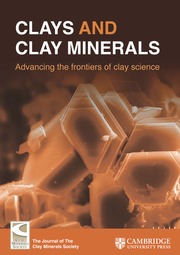Crossref Citations
This article has been cited by the following publications. This list is generated based on data provided by
Crossref.
ZHAO, Wei
FENG, Xionghan
TAN, Wenfeng
LIU, Fan
and
DING, Shuwen
2009.
Relation of lead adsorption on birnessites with different average oxidation states of manganese and release of Mn2+/H+/K+.
Journal of Environmental Sciences,
Vol. 21,
Issue. 4,
p.
520.
Zhao, Wei
Wang, Qing Qing
Liu, Fan
Qiu, Guo Hong
Tan, Wen Feng
and
Feng, Xiong Han
2010.
Pb2+ adsorption on birnessite affected by Zn2+ and Mn2+ pretreatments.
Journal of Soils and Sediments,
Vol. 10,
Issue. 5,
p.
870.
Cui, Haojie
Liu, Fan
Feng, Xionghan
Tan, Wenfeng
and
Wang, Ming Kuang
2010.
Aging promotes todorokite formation from layered manganese oxide at near-surface conditions.
Journal of Soils and Sediments,
Vol. 10,
Issue. 8,
p.
1540.
Zhu, Mengqiang
Ginder-Vogel, Matthew
and
Sparks, Donald L.
2010.
Ni(II) Sorption on Biogenic Mn-Oxides with Varying Mn Octahedral Layer Structure.
Environmental Science & Technology,
Vol. 44,
Issue. 12,
p.
4472.
Yin, Hui
Feng, Xionghan
Qiu, Guohong
Tan, Wenfeng
and
Liu, Fan
2011.
Characterization of Co-doped birnessites and application for removal of lead and arsenite.
Journal of Hazardous Materials,
Vol. 188,
Issue. 1-3,
p.
341.
Frierdich, Andrew J.
Hasenmueller, Elizabeth A.
and
Catalano, Jeffrey G.
2011.
Composition and structure of nanocrystalline Fe and Mn oxide cave deposits: Implications for trace element mobility in karst systems.
Chemical Geology,
Vol. 284,
Issue. 1-2,
p.
82.
Landers, M.
Gräfe, M.
Gilkes, R. J.
Saunders, M
and
Wells, M. A.
2011.
Nickel distribution and speciation in rapidly dehydroxylated goethite in oxide-type lateritic nickel ores: XAS and TEM spectroscopic (EELS and EFTEM) investigation.
Australian Journal of Earth Sciences,
Vol. 58,
Issue. 7,
p.
745.
Liu, Ming-Ming
Cao, Xing-Hui
Tan, Wen-Feng
Feng, Xiong-Han
Qiu, Guo-Hong
Chen, Xiu-Hua
and
Liu, Fan
2011.
Structural Controls on the Catalytic Polymerization of Hydroquinone by Birnessites.
Clays and Clay Minerals,
Vol. 59,
Issue. 5,
p.
525.
Najafpour, Mohammad Mahdi
2011.
Self-assembled layered hybrid [Ru(bpy)3]2+/manganese(iii,iv) oxide: a new and efficient strategy for water oxidation.
Chemical Communications,
Vol. 47,
Issue. 42,
p.
11724.
Qiu, Guohong
Li, Qian
Yu, Ying
Feng, Xionghan
Tan, Wenfeng
and
Liu, Fan
2011.
Oxidation behavior and kinetics of sulfide by synthesized manganese oxide minerals.
Journal of Soils and Sediments,
Vol. 11,
Issue. 8,
p.
1323.
Grangeon, Sylvain
Manceau, Alain
Guilhermet, Julien
Gaillot, Anne-Claire
Lanson, Martine
and
Lanson, Bruno
2012.
Zn sorption modifies dynamically the layer and interlayer structure of vernadite.
Geochimica et Cosmochimica Acta,
Vol. 85,
Issue. ,
p.
302.
Zhao, Wei
Liu, Fan
Feng, Xionghan
Tan, Wenfeng
Qiu, Guohong
and
Chen, Xiuhua
2012.
Fourier transform infrared spectroscopy study of acid birnessites before and after Pb2+ adsorption.
Clay Minerals,
Vol. 47,
Issue. 2,
p.
191.
Yin, Hui
Tan, Wenfeng
Zheng, Lirong
Cui, Haojie
Qiu, Guohong
Liu, Fan
and
Feng, Xionghan
2012.
Characterization of Ni-rich hexagonal birnessite and its geochemical effects on aqueous Pb2+/Zn2+ and As(III).
Geochimica et Cosmochimica Acta,
Vol. 93,
Issue. ,
p.
47.
Wang, Yan
Feng, Xionghan
Villalobos, Mario
Tan, Wenfeng
and
Liu, Fan
2012.
Sorption behavior of heavy metals on birnessite: Relationship with its Mn average oxidation state and implications for types of sorption sites.
Chemical Geology,
Vol. 292-293,
Issue. ,
p.
25.
Ye, Wei
He, Shulian
Ding, Liping
Yao, Yunjin
Wan, Lei
Miao, Shiding
and
Xu, Jinzhang
2013.
Supported Ionic-Liquid “Semi-Heterogeneous Catalyst”: An Interfacial Chemical Study.
The Journal of Physical Chemistry C,
Vol. 117,
Issue. 14,
p.
7026.
Wang, Zimeng
Lee, Sung-Woo
Catalano, Jeffrey G.
Lezama-Pacheco, Juan S.
Bargar, John R.
Tebo, Bradley M.
and
Giammar, Daniel E.
2013.
Adsorption of Uranium(VI) to Manganese Oxides: X-ray Absorption Spectroscopy and Surface Complexation Modeling.
Environmental Science & Technology,
Vol. 47,
Issue. 2,
p.
850.
Figueira, B.A.M.
Angélica, R.S.
da Costa, M.L.
Pöllmann, H.
and
Schenzel, K.
2013.
Conversion of different Brazilian manganese ores and residues into birnessite-like phyllomanganate.
Applied Clay Science,
Vol. 86,
Issue. ,
p.
54.
Remucal, Christina K.
and
Ginder-Vogel, Matthew
2014.
A critical review of the reactivity of manganese oxides with organic contaminants.
Environmental Science: Processes & Impacts,
Vol. 16,
Issue. 6,
p.
1247.
Grangeon, Sylvain
Lanson, Bruno
and
Lanson, Martine
2014.
Solid-state transformation of nanocrystalline phyllomanganate into tectomanganate: influence of initial layer and interlayer structure.
Acta Crystallographica Section B Structural Science, Crystal Engineering and Materials,
Vol. 70,
Issue. 5,
p.
828.
Zhang, Zhijun
Yin, Hui
Tan, Wenfeng
Koopal, Luuk K.
Zheng, Lirong
Feng, Xionghan
and
Liu, Fan
2014.
Zn sorption to biogenic bixbyite-like Mn 2 O 3 produced by Bacillus CUA isolated from soil: XAFS study with constraints on sorption mechanism.
Chemical Geology,
Vol. 389,
Issue. ,
p.
82.

